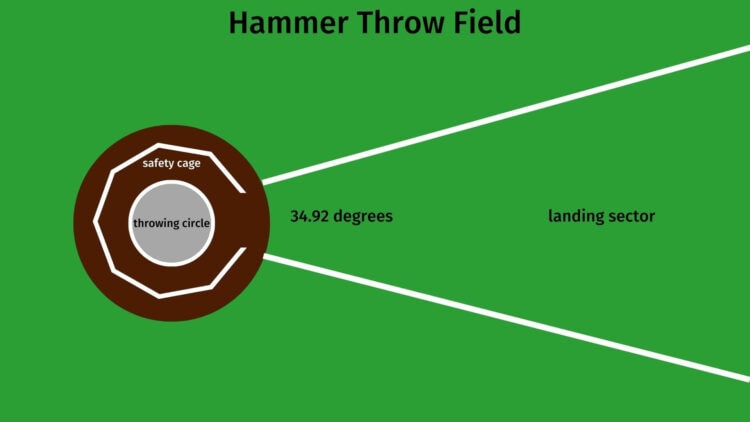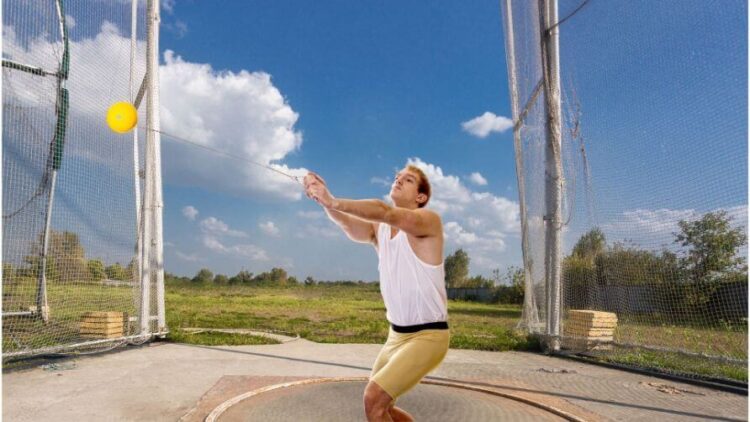
OBJECTIVE OF HAMMER THROW: Throw the “hammer” the farthest distance possible.
NUMBER OF PLAYERS: 1+ player(s)
MATERIALS: Hammer, throwing shoes
TYPE OF GAME: Sport
AUDIENCE: 10+
OVERVIEW OF HAMMER THROW
Hammer throw is one of the four track and field throwing sports, accompanying the likes of discus, javelin, and shotput. As with its counterparts, the primary objective in hammer throw is to toss a projectile the farthest distance possible through the use of exceptional strength and flawless technique.
As with the other throwing sports, the hammer throw has a history dating back thousands of years. It is thought that in 2000 BC, a Celtic warrior named Cuchulainn grabbed a chariot wheel by its axel and chucked it a long distance. However, this is merely a legend, as Cuchulainn is considered a mythological figure who more likely lived in the first century AD.
Legends aside, hammer throw developed rapidly in the medieval era, specifically in Scotland and England. Art from this time period depicts English kings and noblemen throwing actual blacksmith hammers, which is possibly the origin of the sport’s name.
In modern times, hammer throw has been a competitive event since it was featured in the 1900 Olympics. Unlike its previous versions, however, the modern hammer throw features a hammer that doesn’t even remotely resemble the modern tool. This unique design, which is explained further in detail below, has added an entirely new variable of technique to the event.
SETUP
EQUIPMENT
- Hammer: The hammer features a metal ball attached (16 pounds for men, 8.82 for women’s hammer throw competition) to a handle by a 4-foot steel wire.
- Throwing Shoes: These shoes, used in all throwing sports, feature a tight fit and a smooth sole to allow the wearer to spin and glide.
FIELD

Similar to other throwing track and field sports, the hammer throw takes place within a throwing circle, a cage for safety, and a landing sector. The hammer throw field is similar to that of the discus throw. However, the difference is that the hammer throw throwing circle is slightly smaller with a smoother concrete finish. The landing sector is a 35-degree “cone” that starts from the throwing cage and widens as it extends further from the throwing circle.
GAMEPLAY
Athletes are generally allowed six total throws during a hammer throw event. Each throw begins with the athlete standing in the center of a large protective cage (to ensure no bystanders get hit by an errant throw). Inside this cage, the thrower must also remain in the throwing circle (measuring seven feet in diameter) for the duration of their throw.
The thrower holds the hammer by the handle with both hands and begins spinning around for three or four rotations with their arms fully extended in front of them. Similar to other throwing sports, this spinning motion allows the athlete to generate as much power as possible.
After completing their final rotation, the thrower lets go of the hammer, sending it flying down the field. Also similar to the other throwing events, this throw must land within the landing sector.
SCORING
Athletes compete to see who can throw the hammer the farthest. Each competitor is ranked according to their best throw of six total attempts.
On average, Olympic-level athletes score 75- to 85-yard throws, with this range being identical between male and female competitors (due to the differences in hammer weight).
RULES AND FOULS
Other than regulations concerning the construction of the hammer, only two actual rules need to be abided by during a competitor’s throw:
- Throwers must remain within the confines of the throwing circle for the duration of their throw.
- The hammer cannot contact the ground while in the thrower’s hands.
THROWING TECHNIQUE

While strength absolutely plays a factor in the hammer throw, optimal technique is ultimately what separates top competitors in throwing sports.
As previously mentioned, a hammer thrower will hold the hammer by its handle as far away as possible from the body while spinning around three or four times before release. By keeping the hammer as far away from their body as possible, the thrower is able to generate maximum torque for their throw.
However, due to the unique ball-and-chain structure of the hammer, throwers must first perform two stationary spins—that is, they spin the hammer up and over their head to generate their initial momentum. After these two initial spins, the athlete furthers their momentum by spinning their entire body along with the hammer.
During their rotations, the hammer does not spin horizontally around the thrower. Instead, the thrower angles the hammer so that it spins above their head when facing the field before dipping down to knee height when facing the back of the cage. Essentially, the hammer is spun at an angle to allow the thrower to release the hammer at an upwards angle to achieve a throw of maximal distance.
Nazarov wins historic gold in Men’s Hammer Throw
END OF GAME
The athletes throw with the furthest distance after six attempts is crowned the winner of the hammer throw event.
- 30 GAMES TO PLAY OVER TEXT - April 22, 2024
- 20+ FREE PRINTABLE BABY SHOWER GAMES - April 16, 2024
- 20+ College Party Games for the Best Night Ever! - April 2, 2024